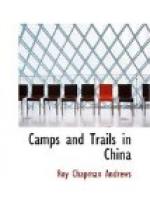A few weeks later we purchased a live flying squirrel from a native and kept it for several days in the hope that it might become tame. The animal was exceedingly savage and would grind its teeth angrily and spring at anyone who approached its basket. It could not be tempted to eat or drink and, as it was a valuable specimen, we eventually chloroformed it.
Just below our camp in a pretty little valley a half dozen families of Lisos were living, and we hired the men to hunt for us. They were good-natured fellows, as all the natives of this tribe seem to be, and worked well. One day they brought in a fine muntjac buck which had been killed with their crossbows and poisoned darts. The arrows were about twelve inches long, made of bamboo and “feathered” with a triangular piece of the same wood. Those for shooting birds and squirrels were sharpened to a needle point, but the hunting darts were tipped with steel or iron. The poison they extracted from a plant, which I never saw, and it was said that it takes effect very rapidly.
The muntjac which the Lisos killed had been shot in the side with a single arrow and they assured us that only the flesh immediately surrounding the wound had been spoiled for food. These natives like the Mosos, Lolos, and others carried their darts in a quiver made from the leg skin of a black bear, and none of the men wished to sell their weapons; I finally did obtain a crossbow and quiver for six dollars (Mexican).
Two days before we left Tai-ping-pu, three of the Lisos guided my wife and me to a large cave where they said there was a colony of bats. The cavern was an hour’s ride from camp, and proved to be in a difficult and dangerous place in the side of a cliff just above a swift mountain stream. We strung our gill net across the entrance and then sent one of the natives inside to stir up the animals while we caught them as they flew out. In less than half an hour we had twenty-eight big brown bats, but our fingers were cut and bleeding from the vicious bites of their needle-like teeth. They all represented a widely distributed species which we had already obtained at Yuen-nan Fu.




